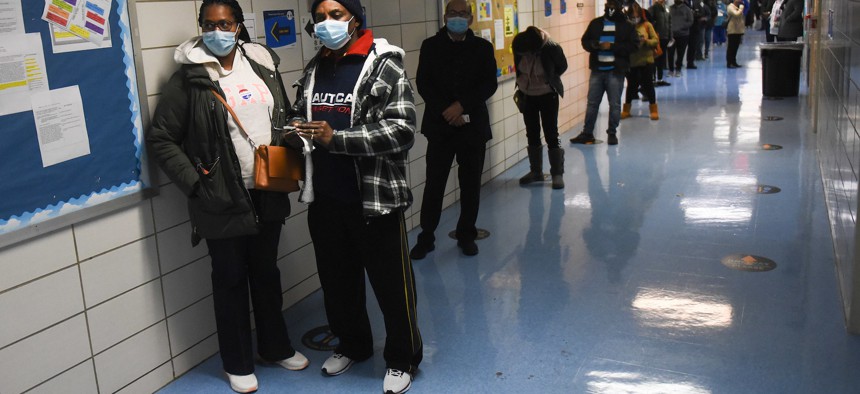New York’s estimated voter turnout for 2020 is 65.3% of eligible voters, ranking New York 30th out of 50 states for voter turnout, and falling below the national average of 66.5%. In 2016, New York ranked 39th in voter turnout, when it was 57.2%. So New York improved in absolute and relative terms, but turnout was up across the nation as well.
New York’s voter turnout is currently only an estimate because it is affected by the unusually large number of absentee ballots cast this year, which have not yet been counted.
New York’s mediocre performance on voter turnout this year is typical of the Empire State, which, despite its progressive politics, ranks below average in key categories for political engagement.
In October, WalletHub’s 2020’s Most & Least Politically Engaged States analyzed 11 metrics related to civic education, voting and political contributions across all 50 states. The study ranked states according to each metric and gave each an overall rating, ranging from most politically engaged to least politically engaged. Data was sourced from the U.S. Census Bureau, the Center for Responsive Politics and Ballotpedia, among others. New York was ranked 23rd out of 50 states for political engagement.
But that middling ranking was brought up by its stronger performance in certain kinds of engagement, such as donating to campaigns across the country. New York was in a four-way tie for first place, with Virginia, Massachusetts and Wyoming, for highest total political contributions per capita.
Notably, New York ranked 47th for registered voters per capita during the 2016 presidential election, sandwiched between New Mexico and Texas. New York had 12,493,250 registered voters in the state in Nov. 2016, which increased to 13,555,547.
Prior to Election Day, more than 1.2 million completed absentee ballots had been sent in by Monday, but that number will increase as New York accepts absentee ballots received up to a week after the election if they are postmarked by Election Day.
However, New York also suffers from an unusually high rate of absentee ballots rejected for voter errors such as neglecting to sign the envelope ABC 7 found that in both the 2018 and 2016 elections, more ballots were rejected in New York City than in any other Democratic-controlled locality. In this year’s primary election, 21% of absentee ballots cast in New York City were rejected. If an individual's ballot is rejected, they must be notified by New York and given the opportunity to mend it.
Jill Gonzalez, an analyst with WalletHub, a site that offers personalized financial data, said that low voter turnout has long been a feature for New York politics. "The main thing New York is lacking is voter turnout,” Gonzalez wrote in an email to City & State. “It registered some of the lowest percentages, both in the 2018 midterm elections, as well as in the 2016 presidential elections. Senior residents in particular are some of the least politically engaged in their age category in the country."
One of the main reasons for the lack of voter participation is the lack of voter accessibility, according to Lina Newton, professor of political science at CUNY Hunter College. “New York’s voter registration law is interesting because New Yorkers have often decried some of the registration laws that have been passed recently in states like Indiana and Georgia that require proof of citizenship and require all kinds of identification, but New York has taken a long time to change some of its laws,” Newton said. Newton went on to describe the lack of same-day voter registration as an example, along with the lack of “no excuse” absentee voting where a voter does not need an excuse, such as an illness, to request an absentee ballot.
New York has recently amended many of its voting restrictions, which could boost turnout in the future, according to Shana Kushner Gadarian, department chair and an associate professor of political science at Syracuse University. “One of the things that that kind of new Assembly and Democratic Senate did in New York state was to pass things like early voting and to pass changes in registration dates to make it easier for people to vote.” In 2019, the newly elected and largely Democratic state Legislature implemented early voting and pre-registration for soon-to-be voters younger than 18. It also passed vote-by-mail and same-day voter registration. However, as those measures would require changing the state constitution, they have to be passed again in 2021 and then approved by voters in a ballot referendum.
The Legislature also created an early voting system, and this election was the first major election in which it was implemented. Over 2.5 million votes were cast prior to Election Day. Early voting, however, came with a caveat: long lines. Although early voting increases accessibility, long lines could deter voters, especially during the COVID-19 pandemic.
Low voter turnout may also be attributable to New York being a safely Democratic state. Craig Burnett, an associate professor of political science at Hofstra University, pointed out. “The state is not very competitive in many races,” Burnett wrote in an email. “Being competitive helps drive registration and turnout, especially at the presidential level.” New York has voted blue for presidential elections since 1988.
Newtown noted that this may be changing, as some congressional or state Legislature districts become more competitive due to demographic or ideological shifts in parts of upstate and the New York City suburbs. “The districts are usually sufficiently gerrymandered to one party or another, usually Democrat in most cases, but there are some Republican seats as well and that tends to squelch voter turnout,” Newton said. “So, if you assume that a party is going to win because it’s always won in the past, you don’t tend to turn out.” However, local elections throughout New York have grown more competitive and may encourage higher voter turnout in the years to come.
NEXT STORY: Rep. Max Rose’s unusual election night speech


